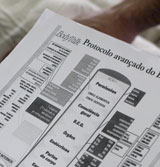Terminology in Treatment
Mar 02, 2017
By John Veltheim
We should all generally understand that when treating clients, it is important to use terminology that they can understand and not use technical terms or terminology that may either confuse them or have no meaning to them. That said, there are situations where using the correct terminology is important.
When I am dealing with patients, particularly lay people, I tend to describe things in terms they can easily relate to. For a long time, I have gotten away with using basic explanations. Of course, now that more people are receiving and seeing my treatments, and some of these people are well-skilled in physical therapy and physiology, they have started to criticize me for using the wrong terminology in certain instances.
One of the most common things I have received criticism for is when working with range of motion tests on the hips by lifting the leg, bending it at the knee, then rotating the leg in and out. When turning the leg in, I have been calling this "internal rotation" for the reason that this is what it looks like to both the patient and anyone viewing the session. When I rotate the leg out, I have been calling this external rotation, again, because that is what it looks like from the client's point of view. These terms make sense to lay people. However, when you rotate it out, it is technically called an internal rotation of the hip joint and vice versa.
Although I have tended to focus on simple explanations for patients, I do recognize that I have not been using the correct terminology from a purely clinical point of view. Although, if I took patient records, I would always notate it in the proper way. I felt it was important to acknowledge the way I have been doing things here, so that people understanding my reasoning. That said, I will make a concerted effort to be more specific and clear, saying things like, for example, "When I rotate the leg internally, which causes the hip joint to rotate externally, this is the range of motion..." And vice versa.
I understand that some people may be critical in thinking that the head of their association should certainly know his basics in testing range of motion. I just wanted to take the opportunity here to clarify that, and I will do my best to become more technically acceptable in the future in order to avoid this kind of unnecessary criticism.
Thank you.
« Back to all news
When I am dealing with patients, particularly lay people, I tend to describe things in terms they can easily relate to. For a long time, I have gotten away with using basic explanations. Of course, now that more people are receiving and seeing my treatments, and some of these people are well-skilled in physical therapy and physiology, they have started to criticize me for using the wrong terminology in certain instances.
One of the most common things I have received criticism for is when working with range of motion tests on the hips by lifting the leg, bending it at the knee, then rotating the leg in and out. When turning the leg in, I have been calling this "internal rotation" for the reason that this is what it looks like to both the patient and anyone viewing the session. When I rotate the leg out, I have been calling this external rotation, again, because that is what it looks like from the client's point of view. These terms make sense to lay people. However, when you rotate it out, it is technically called an internal rotation of the hip joint and vice versa.
Although I have tended to focus on simple explanations for patients, I do recognize that I have not been using the correct terminology from a purely clinical point of view. Although, if I took patient records, I would always notate it in the proper way. I felt it was important to acknowledge the way I have been doing things here, so that people understanding my reasoning. That said, I will make a concerted effort to be more specific and clear, saying things like, for example, "When I rotate the leg internally, which causes the hip joint to rotate externally, this is the range of motion..." And vice versa.
I understand that some people may be critical in thinking that the head of their association should certainly know his basics in testing range of motion. I just wanted to take the opportunity here to clarify that, and I will do my best to become more technically acceptable in the future in order to avoid this kind of unnecessary criticism.
Thank you.








